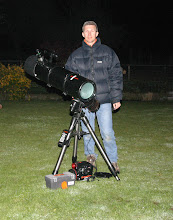This is the first observation this year with a telescope. It's quite cold (something around -3 °C). I'm going for a few Herschel II objects and planetary nebula's
Location: Boutersem (Belgium)
Material: Celestron Advanced GoTo Newton 20cm (8") F5
Eyepieces: Panoptic 24mm and Nagler 16mm - Powermate 2,5x
Naked Eye Limit Magnitude: starting with less than 5.0, ending with somewhat higher than 5.0
Seeing: moderate
Timing: 18:00 UT to 22:30 UT
But we'll start with 2 comets.
Comet Holmes
Visible with naked eye. But it's difficult because it's not yet completely dark. Through the 7x50 finder Holmes is a large round object but still difficult to see. Also at 42x the comet is hardly visible. I can see some nebulosity in the shape of an arc. This arcs becomes a bit more visible with a deepsky filter. Now I can see half of a circle. What a difference with the observations during October and November.
Comet Tuttle
Tuttle is not visible with the naked eye. It's barely visible with my binoculars. But through the finder (7x50) Tuttle is round with a small but bright core. At 64x I can see a coma of 10' with a faint nucleus. The coma is surrounded by some nebula which is round and 25' large. One star is visible through this nebula. A deepsky filter enhances the visibility. The shape looks more triangular than round.
M33 en NGC 604 – galaxy and HII region in Triangulum
NGC 604 is visible at 64x with deepsky filter. It's surprisingly easy to see although averted vision is necessary. At 154x (and deepsky filter) the object is elongated (2:1) and one side seems brighter than the other one.
NGC 513 – galaxy of mag 12.9 in Andromeda
This is a Herschel II object. Difficult. Only visible at 156x and with averted vision. Size is 2’.
NGC 499 – galaxy of mag 12.2 in Pisces
This one is in the neighbourhood of NGC 513. At 156x it's quite easily visible with averted vision. NGC 499 has an oval shape of 3'.
NGC 507 – galaxy of mag 11.3 in Pisces
Also this one is in the neighbourhood of NGC 513. At 156x NGC 507 is a large round object of 4 to 5' with a small core. More difficult than NGC 499.
NGC 7640 – galaxy of mag 11.3 in Andromeda
This is a very difficult object. It's 10' long (!) and hence it has a low surface brightness (SB: 14.5). According to Eye&Telescope the contrast reserve is -0.25, so it would not be visible with my scope. Indeed, at low power I see nothing at all. Maybe, but I say maybe, I can see the South-East side at 154x.
NGC 214 – galaxy of mag 12.2 in Andromeda
At 104x I can see an oval of 3'. Averted vision is required to see this object. The elongation is 2:1 and the direction is NE-SW.
These were the Herschel II objects. Now we have some planetary nebulas in Cassiopeia.
IC 289 – planetary nebula of 35” of mag 13.3 in Cassiopeia
From time to time visible at 154x with OIII filter. It's very difficult, but once in while a disc is visible.
IC 1747 – planetary nebula of 13” of mag 12.1 in Cassiopeia
This one is visible with direct vision at 154x without the aid of any filter. I see a little disc with a bright centre. It reacts very well with an OIII filter.
PK 119-6.1 – planetary nebula of 8” of mag 12.2 in Cassiopeia
At 156x PK 119-6.1 is easily visible as a "star". Observation is confirmed with an OIII filter because it reacts very well.
PK 118-8.1 – planetary nebula of 9” of mag 12.5 in Cassiopeia
Also this one is looking as a star at 156x. Observation is confirmed by OIII and UHC filter. The faint star of mag 12.9 near the nebula was not visible.
PK 111-2.1 – planetary nebula of 2” of mag 13.0 in Cassiopeia
This nebula is situated next to 2 faint stars. So I should see 3 stars, but unfortunately I can see only 2. One star is a bit brighter than the other one. Both stars are of mag 11.5 and 11.7 so I have to conclude I don't seen PK 111-2.1. Who could confirm the nebula is fainter than those 2 stars? Note: http://www.deepskylog.be/ gives magnitude 14.0. Eye&Telescope gives mag 13.0
After all those faint objects it is time for showpiece such a M42 and M43. This was only for a short period, because my Celestron Powertank ran empty. This is strange because it was completely charged before starting to observe. It's a pity because I wanted to continue for 1/2 hour with Herschel II objects in Auriga and Taurus.
Anyway, the evening is a success: 2 comets, 3 HII objects and 4 new planetary nebulas.
Clear skies to you
+v2.jpg)
No comments:
Post a Comment